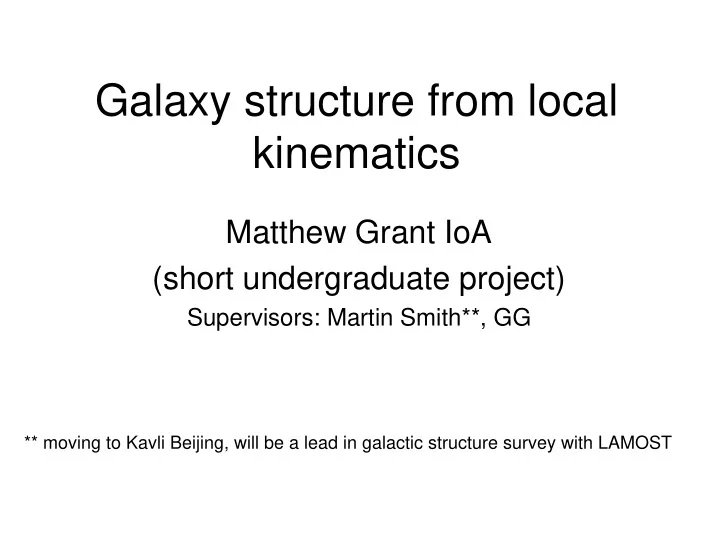

Galaxy structure from local kinematics Matthew Grant IoA (short undergraduate project) Supervisors: Martin Smith**, GG ** moving to Kavli Beijing, will be a lead in galactic structure survey with LAMOST
What is GREAT? • http://www.ast.cam.ac.uk/GREAT/index.html • The ESA Gaia Science Team and the Gaia Data Processing and Analysis Consortium are working with others in the community to build the European science capacity to successfully exploit the upcoming ESA Gaia cornerstone mission. GREAT is the programme which will bring together relevant scientific expertise by promoting topical workshops, training events, exchange visits, conferences and so forth with the aim of addressing the major scientific issues that the Gaia satellite will impact upon. • KickOff – Cambridge March 09: Set of WGs are being set up. • One is to promote wide-field spectroscopic capability on 4-m class telescopes • - this is meeting in Cambridge, July 8/9 • Coordinated with the two AstroNet/Opticon reviews • 1) ETSRC – future of 2-4m telescopes co-chairs: Janet Drew, Jacqueline Bergeron http://www.strw.leidenuniv.nl/2to4mtelescopes/ • 2) wide-field spectroscopy on 4-8m telescopes – being implemented now.
Given the complexity of local phase- space, do full statistical/Jeans’ equation analyses mean anything. If so, why?? New Hipparcos catalogue: finds usual number of local ``structures`` - ten Bovy etal 0905.2980
Does RAVE tell us anything useful about the different histories of thick and thin disks?? Do we see significant different mean motions? Scales? Element ratio data from Fuhrmann
Quillen & Galactic U , V , W Garnett (2001) space velocities: W V U U V 189 F-G dwarf stars W
Local sdss subdwarf kinematics – RAVE volume , 1800 stars Smith etal 0904.1012
RAVE sub-sample: Sample: 248K internal list log g >3* sigma_rv < 5 [Fe/H]_corr >-1 (<+5) selects 62611 stars fitting uses 200 bootstrap samples • This is a mistake- some giants survive the cut
• Mean velocity vs colour • Extremely constant in U,W U • Parenago discontinuity at J-K = 0.3 V 0.2 0.4 0.6 0.8 J-K W
Total velocity dispersion vs J-K colour
Asymmetric drift: Mean U, V, W motion vs velocity dispersion Very constant in U, W Very tight correlation in V implies LSR for thin and thick disk -and halo- are the same – -no large scale asymmetries -large-scale equilibrium
Diagonal dispersion (U^2, V^2, W^2) vs J-K colour Note: -smooth trend in U,V into thick disk -dip in red – giant contamination? -high sigma_W shows thick disk
• Simple statistical fitting of kinematics for RAVE stars with [Fe/H]>-1, log g>3 – includes thin and thick disks • `solar motion` very well defined over whole range no larger scale thick disk motion it has been there a long time? • Dispersion relation very smooth: similar Jeans’ fits to thin and thick disk similar radial scale lengths? • LSR values are robust, even though local velocity DF is extremely clumpy – why is sampling noise not dominant? • velocity phase-space clumps cannot correspond to large gravitational potential fluctuations?
Recommend
More recommend